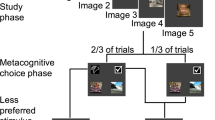Abstract
Humans use memory awareness to determine whether relevant knowledge is available before acting, as when we determine whether we know a phone number before dialing. Such metacognition, or thinking about thinking, can improve selection of appropriate behavior. We investigated whether rhesus monkeys (Macaca mulatta) are capable of a simple form of metacognitive access to the contents of short-term memory. Monkeys chose among four opaque tubes, one of which concealed food. The tube containing the reward varied randomly from trial to trial. On half the trials the monkeys observed the experimenter baiting the tube, whereas on the remaining trials their view of the baiting was blocked. On each trial, monkeys were allowed a single chance to select the tube containing the reward. During the choice period the monkeys had the opportunity to look down the length of each tube, to determine if it contained food. When they knew the location of the reward, most monkeys chose without looking. In contrast, when ignorant, monkeys often made the effort required to look, thereby learning the location of the reward before choosing. Looking improved accuracy on trials on which monkeys had not observed the baiting. The difference in looking behavior between trials on which the monkeys knew, and trials on which they were ignorant, suggests that rhesus monkeys discriminate between knowing and not knowing. This result extends similar observations made of children and apes to a species of Old World monkey, suggesting that the underlying cognitive capacities may be widely distributed among primates.


Similar content being viewed by others
References
Call J, Carpenter M (2001) Do apes and children know what they have seen? Anim Cogn 4:207–220
Clark RE, Squire LR (1998) Classical conditioning and brain systems: the role of awareness. Science 280:77–81
Cohen NJ, Eichenbaum H, Deacedo BS, Corkin S (1985) Different memory systems underlying acquisition of procedural and declarative knowledge. In: Olton DS, Gamzu E, Corkin S (eds) Memory dysfunction: an integration of animal and human research from preclinical and clinical perspectives. New York Academy of Sciences, New York, pp 54–71
Cowey A, Stoerig P (1995) Blindsight in monkeys. Nature 373:247–249
Gallup GG (1994) Self-recognition: research strategies and experimental design. In: Parker ST, Mitchell RW, Boccia ML (eds) Self-awareness in animals and humans. Cambridge University Press, New York, pp 35–50
Hamman SB, Squire LR (1997) Intact perceptual memory in the absence of conscious memory. Behav Neurosci 111:850–854
Hampton RR (2001) Rhesus monkeys know when they remember. PNAS 98:5359–5362
Hampton RR (2003) Metacognition and explicit representation in nonhumans. Behav Brain Sci 26:346–347
Hampton RR, Murray EA (2002) Learning of discriminations is impaired, but generalization to altered views is intact, in monkeys (Macaca mulatta) with perirhinal cortex removal. Behav Neurosci 116:363–377
Heyes CM (1994) Reflections on self-recognition in primates. Anim Behav 47:909–919
Inman A, Shettleworth SJ (1999) Detecting metamemory in nonverbal subjects: a test with pigeons. J Exp Psychol Anim Behav Process 25:389–395
Kerns JG, Cohen JD, MacDonald AW, Cho RY, Stenger VA, Carter CS (2004) Anterior cingulate conflict monitoring and adjustments in control. Science 303:1023–1026
Kirk RE (1982) Experimental design, 2nd edn. Wadsworth, Belmont, Calif.
Knowlton BJ, Squire LR (1993) The learning of categories: parallel brain systems for item memory and category knowledge. Science 262:1747–1749
Knowlton BJ, Ramus S, Squire LR (1992) Intact artificial grammar learning in amnesia. Psychol Sci 3:172–179
Matsumoto K, Tanaka K (2004) Conflict and cognitive control. Science 303:969–970
Metcalfe J (2003) Drawing the line on metacognition. Behav Brain Sci 26:350–351
Murray EA, Mishkin M (1986) Visual recognition in monkeys following rhinal cortical ablations combined with either amygdalectomy or hippocampectomy. J Neurosci 6:1991–2003
Parker A (1998) Primate cognitive neuroscience: what are the useful questions? Behav Brain Sci 21:128–128
Purdy JE, Domjan M (1998) Tactics in theory of mind research. Behav Brain Sci 21:129–130
Riley DA, Langley CM (1993) The logic of species comparisons. Psychol Sci 4:185–189
Schall JD (2001) Neural basis of deciding, choosing and acting. Nat Rev Neurosci 2:33–42
Shettleworth SJ, Sutton JE (2003) Animal metacognition? It’s all in the methods. Behav Brain Sci 26:353–354
Shillito DJ, Gallup GG, Beck BB (1999) Factors affecting mirror behavior in western lowland gorillas, Gorilla gorilla. Anim Behav 57:999–1004
Smith JD, Shields WE, Washburn DA, Allendoerfer KR (1998) Memory monitoring by animals and humans. J Exp Psychol 127:227–250
Smith JD, Shields WE, Washburn DA (2003) The comparative psychology of uncertainty monitoring and metacognition. Behav Brain Sci 26:317–339
Tomasello M, Call J (1997) Primate cognition. Oxford University Press, New York, N.Y.
Tulving E, Schacter DL (1990) Priming and human memory systems. Science 247:301–306
Weiskrantz L (2001) Commentary responses and conscious awareness in humans: the implications for awareness in non-human animals. Anim Welfare 10:S41–46
Acknowledgements
We thank David Ide of Research Services Branch, National Institute of Mental Health, Bethesda, Maryland, for fabricating the apparatus, making critical contributions to the apparatus design, and taking the photos shown in Fig. 1. We thank Josep Call for encouragement, helpful discussions, and sharing unpublished data. These experiments comply with US law.
Author information
Authors and Affiliations
Corresponding author
Rights and permissions
About this article
Cite this article
Hampton, R.R., Zivin, A. & Murray, E.A. Rhesus monkeys (Macaca mulatta) discriminate between knowing and not knowing and collect information as needed before acting. Anim Cogn 7, 239–246 (2004). https://doi.org/10.1007/s10071-004-0215-1
Received:
Revised:
Accepted:
Published:
Issue Date:
DOI: https://doi.org/10.1007/s10071-004-0215-1




